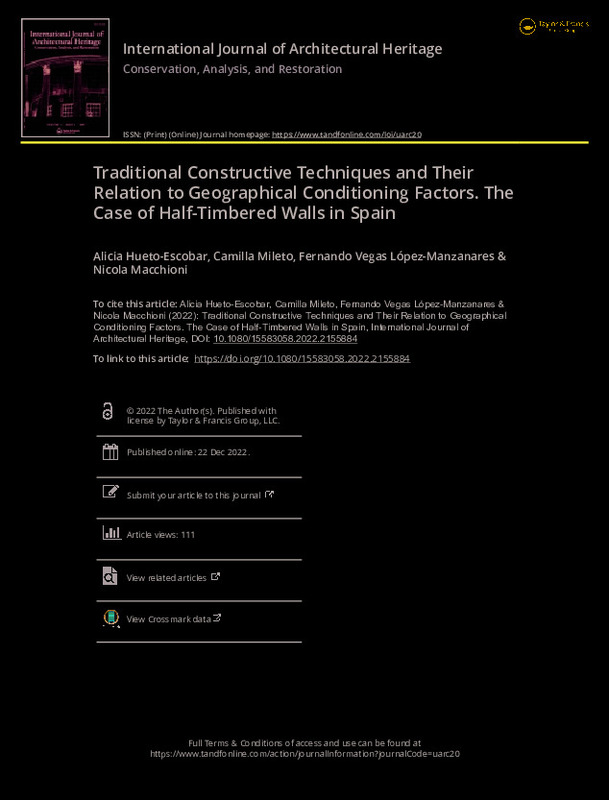JavaScript is disabled for your browser. Some features of this site may not work without it.
Buscar en RiuNet
Listar
Mi cuenta
Estadísticas
Ayuda RiuNet
Admin. UPV
Traditional Constructive Techniques and Their Relation to Geographical Conditioning Factors. The Case of Half-Timbered Walls in Spain
Mostrar el registro sencillo del ítem
Ficheros en el ítem
| dc.contributor.author | Hueto-Escobar, Alicia
|
es_ES |
| dc.contributor.author | Mileto, Camilla
|
es_ES |
| dc.contributor.author | Vegas López-Manzanares, Fernando
|
es_ES |
| dc.contributor.author | Macchioni, Nicola
|
es_ES |
| dc.date.accessioned | 2023-12-14T19:01:42Z | |
| dc.date.available | 2023-12-14T19:01:42Z | |
| dc.date.issued | 2022-12 | es_ES |
| dc.identifier.issn | 1558-3066 | es_ES |
| dc.identifier.uri | http://hdl.handle.net/10251/200767 | |
| dc.description.abstract | [EN] Traditional architecture is the result of collective experience in the optimum use of available materials in a given location and adapted to specific conditions and needs. Although forms and groups also depend on other cultural and social issues, the constructive techniques used depend mostly on geographical conditioning factors such as altitude, hydrography, lithology, climate, etc. This text aims to analyse the possible relationships among the multiple variants and specific geographical conditioning factors of each location; in turn, this should provide an understanding of the reasons motivating or reducing their use and the mechanisms adapting these techniques to these conditioning factors. The analysis cross-referenced GIS systems from a database compiling information on 1160 half-timbered walls with a series of themed maps containing information on geographical factors. The conclusions reached show that a single technique adapts to different geographical conditioning factors, giving rise to a wide range of solutions which can provide greater durability and improved habitability. This capacity to adapt to the location is a lesson in sustainability that can be applied at present and is above all part of the intrinsic wealth and value of traditional architecture. | es_ES |
| dc.description.sponsorship | This work is part of the research project "La arquitectura de tierra en la Peninsula Iberica: Estudio de los riesgos naturales, sociales y antropicos y estrategias de intervencion e incremento de la resiliencia" Risk-Terra (ref. RTI2018-095302-B-I00, MCIU/AEI/FEDER, UE; main researchers: Camilla Mileto & Fernando Vegas), funded by the Spanish Ministry of Science, Innovation and Universities/Ministerio de Ciencia, Innovacion y Universidades. This research has been developed within a doctoral thesis funded by the Spanish Ministry of Science, Innovation and Universities/Ministerio de Ciencia, Innovacion y Universidades (Ref. FPU18/01596). Funding for open access charge: Universitat Politecnica de Valencia [FPU18/01596,RTI2018-095302-B-I00]. | es_ES |
| dc.language | Inglés | es_ES |
| dc.publisher | Taylor & Francis | es_ES |
| dc.relation.ispartof | International journal of architectural heritage (electronic) | es_ES |
| dc.rights | Reconocimiento - No comercial - Sin obra derivada (by-nc-nd) | es_ES |
| dc.subject | Adaptation | es_ES |
| dc.subject | Climatic factors | es_ES |
| dc.subject | Geographical distribution | es_ES |
| dc.subject | Geological factors | es_ES |
| dc.subject | Half-timber | es_ES |
| dc.subject | Traditional architecture | es_ES |
| dc.subject | Wattle-and-daub | es_ES |
| dc.subject.classification | COMPOSICION ARQUITECTONICA | es_ES |
| dc.title | Traditional Constructive Techniques and Their Relation to Geographical Conditioning Factors. The Case of Half-Timbered Walls in Spain | es_ES |
| dc.type | Artículo | es_ES |
| dc.identifier.doi | 10.1080/15583058.2022.2155884 | es_ES |
| dc.relation.projectID | info:eu-repo/grantAgreement/AEI/Plan Estatal de Investigación Científica y Técnica y de Innovación 2017-2020/RTI2018-095302-B-I00/ES/LA ARQUITECTURA DE TIERRA EN LA PENINSULA IBERICA: ESTUDIO DE LOS RIESGOS NATURALES, SOCIALES Y ANTROPICOS Y ESTRATEGIAS DE INTERVENCION E INCREMENTO DE LA RESILIENCIA/ | es_ES |
| dc.relation.projectID | info:eu-repo/grantAgreement/MCIU//FPU18%2F01596//AYUDA PREDOCTORAL FPU-HUETO ESCOBAR. PROYECTO: LOS MUROS ENTRAMADOS DE MADERA EN ESPAÑA: ESTUDIO DE UNA TÉCNICA TRADICIONAL PARA SU PUESTA EN VALOR Y CONSERVACIÓN/ | es_ES |
| dc.rights.accessRights | Abierto | es_ES |
| dc.contributor.affiliation | Universitat Politècnica de València. Centro de Investigación Arquitectura, Patrimonio y Gestión para el Desarrollo Sostenible - Centre d'Investigació Arquitectura, Patrimoni i Gestió per al Desenvolupament Sostenible | es_ES |
| dc.contributor.affiliation | Universitat Politècnica de València. Escuela Técnica Superior de Arquitectura - Escola Tècnica Superior d'Arquitectura | es_ES |
| dc.description.bibliographicCitation | Hueto-Escobar, A.; Mileto, C.; Vegas López-Manzanares, F.; Macchioni, N. (2022). Traditional Constructive Techniques and Their Relation to Geographical Conditioning Factors. The Case of Half-Timbered Walls in Spain. International journal of architectural heritage (electronic). 1-23. https://doi.org/10.1080/15583058.2022.2155884 | es_ES |
| dc.description.accrualMethod | S | es_ES |
| dc.relation.publisherversion | https://doi.org/10.1080/15583058.2022.2155884 | es_ES |
| dc.description.upvformatpinicio | 1 | es_ES |
| dc.description.upvformatpfin | 23 | es_ES |
| dc.type.version | info:eu-repo/semantics/publishedVersion | es_ES |
| dc.relation.pasarela | S\484221 | es_ES |
| dc.contributor.funder | AGENCIA ESTATAL DE INVESTIGACION | es_ES |
| dc.contributor.funder | European Regional Development Fund | es_ES |
| dc.contributor.funder | Ministerio de Ciencia, Innovación y Universidades | es_ES |
| dc.contributor.funder | Universitat Politècnica de València |








